|
1. Revised edition of "Motif of Premodern Porcelain, influential relationship between Chinese and Hizen ware"
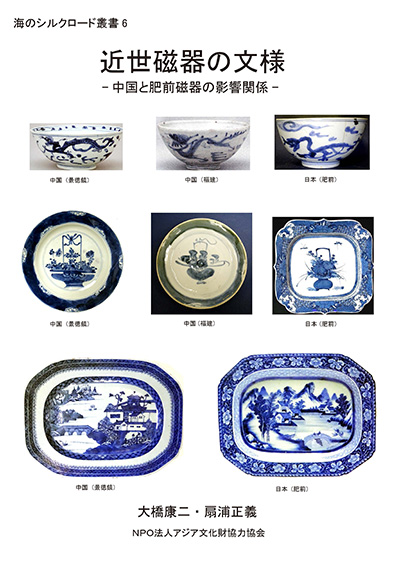
the cover of revised version | |
Due to invisible condition of image in this digital publication by Ohashi Koji & Ogiura Masayoshi, published in last April 26, we have already published again the revised version. If you bought the first version and can show certificate of Kindle Digital Publication/Amazon, we shall send PDF of the revised version. |
2. A new digital publication "Motifs of Pre-modern Porcelain, influential relation between Chinese and Hizen porcelain"
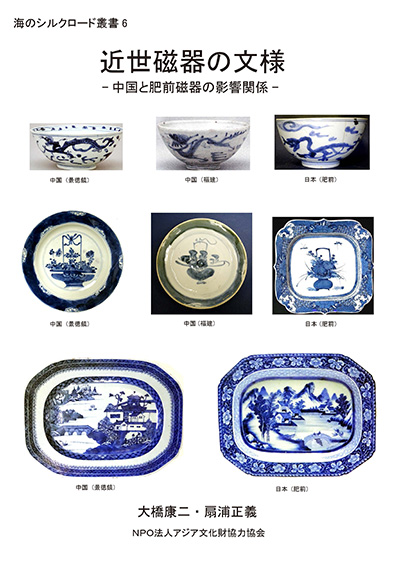
the cover | |
As the series of Sea Silk-road vol.6, we have already published Ohashi Koji & Ogiura Masayoshi "Motifs of Pre-modern porcelain, influential relation between Chinese and Hizen porcelain" by Kindle Digital Publication of Amazon (64 pages, 25 figure pages, JPYen 1,000). For motifs in Chinese and Hizen porcelains, the influential relation was discussed by comparison of similar examples in each 25 kinds motifs. In all figure pages about 60 motif units, selected from archaeological data & collection of museums, were shown by each 10 periods. The reader will be well able to understand influential relation both Chinese and Hizen porcelains through comparison of motifs in this book. 6 digital books of the series of Sea Silk-road are selling as Kindle Digital Publication, however, if enter into our membership (JPYen 3,000 for a year), all PDF version will be distributed without any payment. |
3. 2025-4-26: Open Lecture of Ohasi Chief Diredtor "The real condition of the beginning of Hizen porcelain by the 17th C. and characteristics of porcelains found in Taiwan, concerned the export to Southeast Asia
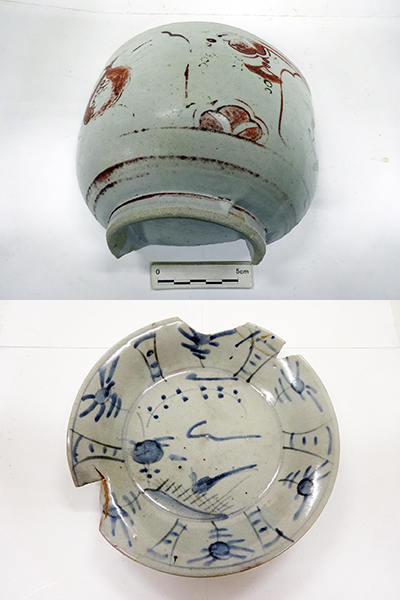
polychrome dish from Fukiage Beach & b&w dish of Yagenji Kilin, Arita | |
With cosponsor of Japan Society for Southeast Asian Archaeology, we shall carry out the open lecture of Ohashi Koji Chief Director by on-line at 15:00 (possible to enter 14:45, Q&A after 16:30), April 26, 2025. The lecture firstly will introduce the beginning of production of Hizen porcelain based on the result of kilns excavation in Taku and Imari as the trial and Arita for the full-dress production. Then, explain the export to Southeast Asia by characteristics of findings of Chinese/Hizen wares in Taiwan as an example of the change from Chinese to Hizen porcelians. You may join into this lecture by Zoom online meeting (meeting ID:899 5092 1066, passcode:830952). |
4. April 13, 2024: Public lecture of Ohashi Chief Director 'Hizen wares, exported world - focus on export to Southeast Asia'
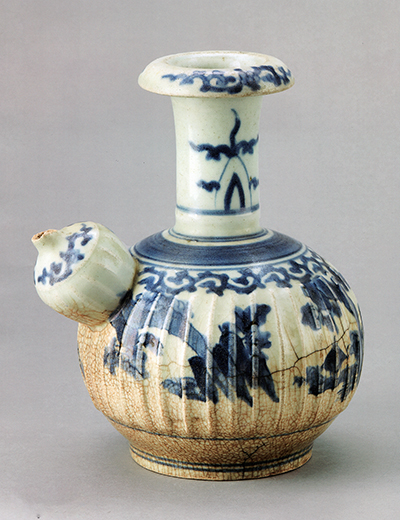
Hizen blue&white kendi, found in Nakhon Si Thammarat, Thailand | |
Public lecture of Ohashi Koji Chief Director will be held under cosponsor of Japan Society for Southeast Asian Archaeology by on-line during 3:00 - 4:30 PM (open after 2:30 PM), April 13, 2024. Outline: I will survey distribution of trade ceramics after the 14th century until the 18th century in Southeast Asia. Among them, much number of Hizen wares were entered instead of Chinese porcelain due to the civil war of dynasties change from Ming to Qing during 1644 and 1684. In this lecture, explain its characteristics, chronological detail and differences with porcelain for Europe.It is needed advance registration; please apply by following URL.https://us02web.zoom.us/meeting/register/tZ0tdO2qpjsjH9YycmKgavb5_mO6ZYNHbykE |
5. Publishment of "Chinese Qing porcelain found in Pre-modern Nagasaki, motif version"
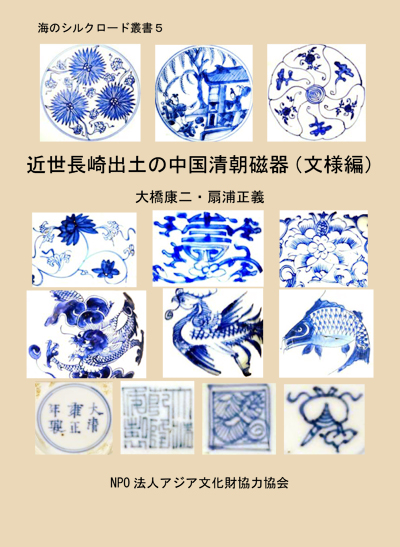
Chinese Qing porcelain found in Pre-modern Nagasaki, motif version | |
We have already published this digital publication by Ohashi Koji & Ogiura Masayoshi in the Kindle Store of Amazon. This is the sequel to publication of the same authors in last year. Motifs of Qing porcelain found in Nagasaki were classified by each kinds and described in detail chronological condition both Jingdezhen and Fujian kilns. In 23 figures much number of each motif units, distilled from porcelain shards, were entered. With consideration of meaning of motifs, this publication would be thought as a no example publication for understanding common Qing porcelains. |
6. Publication of CHINESE QING PORCELAINS FOUND IN PRE-MODERN SITES OF NAGASAKI
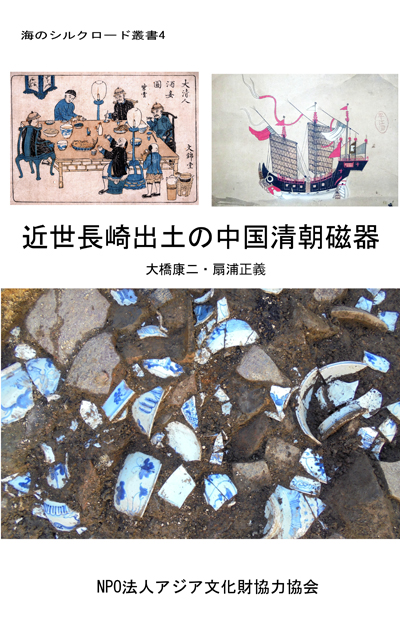
the Cover Page | |
As the Sea-Silkroad Series no.4, this digital book, co-written Ohashi Koji & Ogiura Masayoshi, has been published by Kindle Digital Publication of Amazon. Numerous Qing common porcelains, found in the Chinese Residence site etc., were analyzed into 5 manufacturing places with 5 periods, and explained each 16 form. For understanding the Qing porcelains from not only domestic Japan but also Taiwan and Southeast Asia, data of Nagasaki with chronological information from time-scale by fire layers etc. is really important. This digital publication with 19 color chronological figures can be bought in cheaper price by Amazon. |
7. Online open lecture of Ohashi Chief Director by April 15, 2023
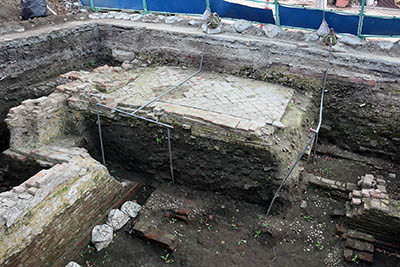
The excavtion on Tayouan site in Taiwan, the hub port Nagasaki and Southeast Asia | |
With cosponsor of the Japanese Society for Southeast Asian Archaeology, we shall hold online lecture of Ohashi Koji Chief Director, 'Change from Hizen porcelain to Qing porcelain during the 17th and 19th centuries, concentrated Nagasaki, Taiwan and Southeast Asia' in 2:30 - 4:30 pm. Summary is followed; By 1644 the export of Chinese porcelain drastically decreased due to the Civil War of dynasties change from Ming to Qing. Instead of Chinese porcelain the export of Hizen porcelain was gradually developed and reached the peak in the 1655-70s. After 2nd half of the 1670s again Jingdezhen ware was slowly begun to export to Indonesia etc. And after finish of the Civil War, in 1684 the export of Chinese porcelain became full-dress when Qing started the open trade policy. I will explain this fact based on findings from the Chinese Residence Ruins in Nagasaki, and discuss distribution of porcelains in Taiwan and Southeast Asia by comparison with this site.'You may join into this online lecture from web-site of the Japanese Association for Southeast Asian Archaeology (needed advance registration). |
8. New publishment: Motifs of Chinese Ming porcelain found in Pre-Modern Nagasaki
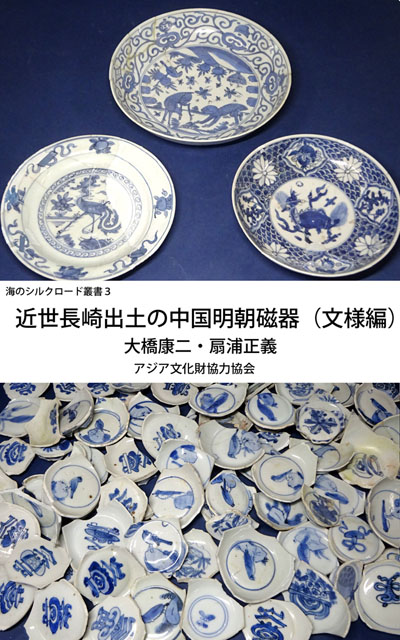
Cover page | |
This Ohashi Koji & Ogiura Masayoshi's new digital issue has been published as the Sea Silk Road Series vol.3. Followed previous publication for the classification, this new one explains variation of motifs of Chinese Ming porcelains found by archaeological excavation in Nagasaki. Analysis on classification and dating of Ming porcelains (Jingdezhen & Zhangzhou) based on real archaeological findings, which influenced to Japanese Hizen ware and never tried in China, certainly give large scientific meaning. This digital publication, 40 pages including 20 color figures, is selling by Kindle Store of Amazon with price 700 Japanese Yen. |
9. Ohashi Chief Director Online Lecture by pm 3:00-4:30, Apr 9, 2022: The beggining and change of the Nabeshima ware
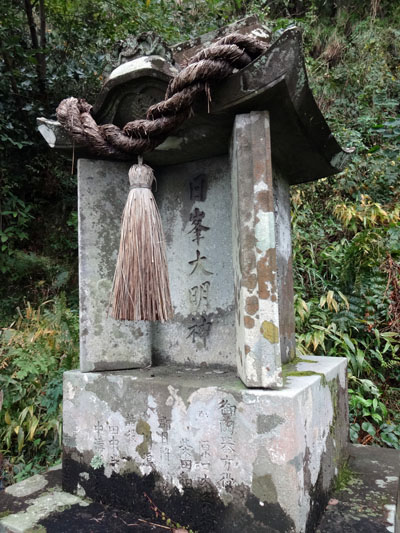
Nipposha-Shita Shrine, Okawachi, Imari | |
The finest porcelain for the Tokugawa royal family, manufactured by Nabeshima Lord in Saga in the Edo Period, is called the Nabeshima ware now. After 1644 they had developed and started to gift this ware instead of imported Chinese porcelain. The official kiln was moved from Arita to Okawachi, Imari by 1659, and the earliest official kiln is the Nipposha-shita kiln, which was found the Early Nabeshima ware with blue & white bowl/dish for Southeast Asian market. In this lecture, it will be explained the characteristics and dating and procedure of changing condition to the Middle Nabeshima ware.You may join into this lecture by following;https://us02web.zoom.us/meeting/register/tZYsf-igqD8vGtzQ-9MjQefl0JPsoMtTcl92 |
10. Publication of 2 titles of the Maritime Silk Road series
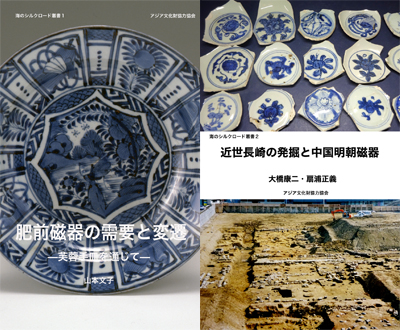
cover pages in digital publication | |
With purpose for the establishment of cooperative relation in cultural properties fields beyond sea and differences of languages with history, in April 4 we have carried out digital publication through Kindle Direct Publishing of Amazon for 2 titles in Japanese; Yamamoto Ayako's "Demand and Changes of the Hizen ware, focusing the Kraak style dish" and Ohashi Koji with Ogiura Masayoshi's "Archaeological Excavation in Pre-Modern Nagasaki and Chinese Late Ming porcelains". You may read both works with rich figures by tablet PC etc. by cheep price. |
11. On-line lecture of Ohashi Chief Director in April 17, 2021

The Chinese Residece of Nagasaki | |
Postponed lecture of Ohashi Koji Chief Director 'Qing porcelains found in the Chinese Residence of Nagasaki and concerned finding condition in Southeast Asia' will be held by on-line with Japan Society of Southeast Asian Archaeology in 14:00-16:00, Apr 17, 2021. He will introduce much Qing porcelains of the Chinese Residence, presumed dating, with resembled examples in Southeast Asian archaeological sites. Please register in https://forms.gle/gw9m6NCKvuLXts6x9 before 15:00 Apr 16. After this time will be sent the link of Zoom for participation. |
12. Postponment of Lecture Meeting of Chief Director Ohashi Koji in April 18
|
Due to the infection expansion of COVID-19 in Tokyo, Sophia University, place of the lecture meeting, decided to extend the prohibition of all event and out-course activities till April 26. Because of this, we should put off the lecture meeting, scheduled in April 18. By consideration of change of the condition, we shall announce the new date again. |
13. Lecture of Ohashi Koji Chief Dirctor: Ceramics found in Southeast Asia and the result of research on the Chinese Residence in Nagasaki
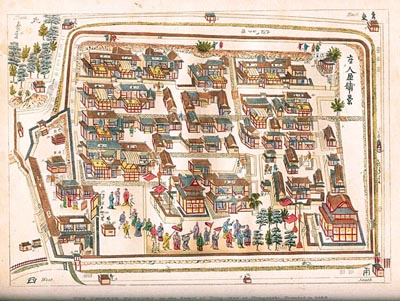
The Chinese Residence in Nagasaki | |
place: 509 room of no.2 building, Sophia University (Yotsuya, Tokyo) date: am 10:00-12:00, Apr 18, 2020 Cosponsor: Japan Society of Southeast Asian Archaeology & Institute of Asian, African, and Middle Eastern Studies Sophia University For ceramics found in the Chinese Residence in Nagasaki, has been held excavation research 7 times after 1992 by Nagasaki City, it will be compared and discussed with findings in Southeast Asia. In Nagasaki the Chinese traders were forced to stay in this residence after 1689 till the end of Tokugawa period, and they had continued to use Qing ceramics as only one place in Japan except Okinawa. Recently, a new whole study,classified all ceramics in 5 periods, has been appeared. |
14. The Tenth Anniversary of the Establishment: Lecture Meeting of Ohashi Koji Chief Director in April 15, 2017
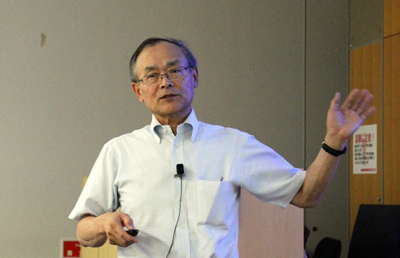
Ohashi Koji Chief Director | |
Our association has been passed 10 years after the establishment, and we realized cooperated activities with Indonesian National Archaeology Study Center, in particular, works related with ceramic findings from archaeological sites in Indonesia. For purpose of introduction of the results, we shall publish \\\"Hizen wares found in capital sites in Indonesia, Trowulan Site etc.\\\". Also, we shall hold a open lecture meeting of Chief Director Prof. Ohashi Koji as followed; Date: April 15, 14:00-16:00 Place: Tokyo Archaeology Center Address: Ochiai 1-14-2, Tama, Tokyo 206-0033 Tel. 042-373-5296 Title: Chinese Porcelain of Ming-Qing, blue & white ware, found in Japan and others Contents: Regarding present study of Ming-Qing porcelain found in Japan and Southeast Asia |
15. A lecture meeting of Ohashi Koji Chief Director in July 16, 2016
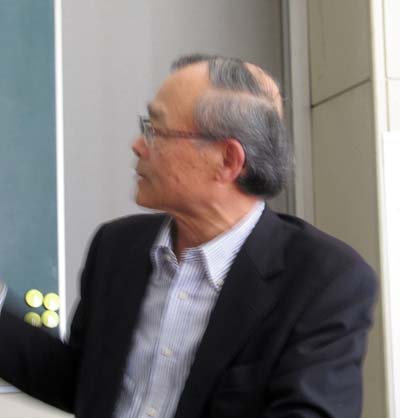
Ohashi Chief Director in Fukuoka | |
We shall hold a lecture meeting of Ohashi Koji Chief Director, as followed; Topic: Trade Ceramics of Cambodia and Lao Date: PM3:00-5:00, July 16, 2016 (open 2:30) Place: Toyama Campus 36th Building 382 room. Waseda University 5 minutes from Waseda station of Tozai Line, Tokyo Metro This lecture is a report of field research of Ohashi Chief Director in previous winter season. The Japan Society for Southeast Asian Archaeology will cosponsor for this meeting. |
16. Practice the additional analysis for ceramic shards found in Trowulan Archaeological Site

Reconstructed Vietnamese brown glaze dog ornament | |
With Indonesian Archaeological Center, we have done the analysis activity of ceramic shards, found in Trowulan Archaeological Site, Mojokerto, East Java, Indonesia, during Aug 2-9, 2015. This activity, aimed to supplement previous analysis in 2012-13, included classification for unclassified shards and making drawing for important shards. We could reconstruct some Vietnamese ornaments, while the majority had been broken with small parts so difficult to imagine the original. By this work, it has become to clear the whole condition of numerous ceramic shards in Trowulan. We are assured it should support for understanding of the substance of this site, have been entered into Indonesian tentative list for World Heritage. |
17. Open Lecture of Ohashi Chief Director & Nogami Director in Apr.18
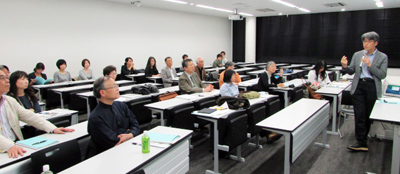
Lecture of Prof. Nogami | |
We held a open lectures meeting by Ohashi Chief Director and Nogami Director in Kanda Campus of Senshu University, Tokyo, Apr 18, 2015. Prof.Ohashi reported resarch result of Kakiemon style porcelains corrected in Europe with title, Characteristics of the typical Kakiemon style Hizen wares both European exoprt and findings in Japan, while Prof.Nogami explained research result for exported Hizen wares found in Mexico and Cuba with title, Ceramics abroad the Pacific Ocean. About 50 persons, included Prof. Kikuchi, participated in this meeting, cohosted by Japan Association for Southeast Asian Archaeology, and eagerly heard two lectures. |
18. Public lectures of OHASHI Koji and NOGAMI Kenki in Tokyo, Apr 18, 2015
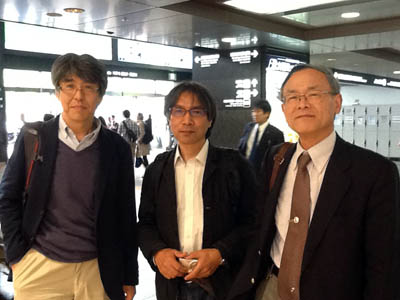
OHASHI Koji (R) & NOGAMI Kenki (L) | |
We shall hall public lecture by our directors as followed; Date: Apr 18, 14:00 open Place: 541 room in No.5 buil of Senshu University Kanda Campus (3 minutes from Kudanshita or Jinbocho station of Tokyo Metro) Program: 1. OHASHI Koji , chief director, Characteristics of typical Kakiemon style for European export and its findings in Japan, 14:30-15:30 2. NOGAMI Kenki, director, Ceramics abroad the Pacific Ocean, 15:30-16:30 Welcome you to join these lectures without payment! |
19. Held the Lectures Meeting at Tokyo in July 26

Ohashi Chief Director | |
Our annual Tokyo lectures meeting was held at Waseda University, under auspices with Japan Society for Southeast Asian Archaeology. In this time, we prepared two lectures; Ohashi Chief Director, ’Towards the understanding of manufacturing technique of Japanese polychrome ware’ and Sakai Vice Director, ’The investigations for tile decoration buildings in Asia’ Chief Director explained the result of archaeological excavation on Yanbeta Kiln ruins, Arita, Saga, which was manufacturing center of the early polychrome ware in Japan, while Vice Director talked filed research experience in India and West Asia related the origin of Vietnamese tile found in Trowulan, Indonesia. About 30 participants heard lectures in very hot this day. |
20. The Special Lecture Meeting in Tokyo, July 26, 2014
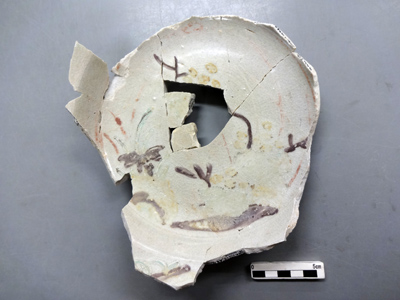
Polychrome dish found in Yanbeta Site | |
We shall held the special lecture meeting on July 26 in Tokyo by collaboration with Japan Society for Southeast Asian Archaeology.Date: 15:00-18:30, July 26Place: No.434 room in No.33 building, Toyama Campus, Waseda UniversityAcces: 3 minutes from Waseda Sta. of Tokyo MetroLecture 1: OHASHI Koji, ’Towards to Understanding of the early technique of Japanese polychrome celadon, the result of investigation in Yanbeta Site, Arita, SagaLecture 2: SAKAI Takashi, the investigation of glazed tile decorated buildings in Asia, related with Vietnamese tile found in Indonesia |
21.
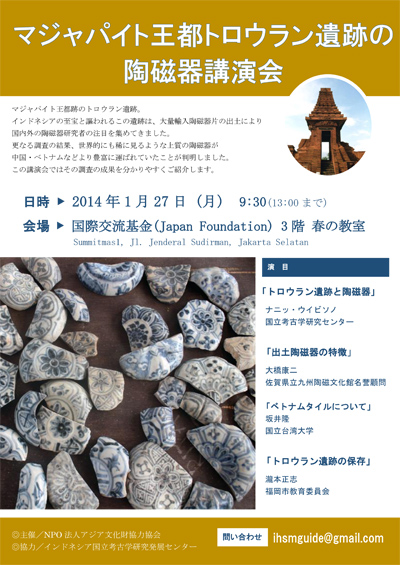
A free open lecture in Jakarta | |
We shall hold a free public lectures for the result of ceramic analysis works, found in Trowulan by 2 times, in Jakarta, as following;Date: Jan 27 (Monday), 2014 9:30-13:00Place: Haru room in the Japan Culture Center, The Japan Foundation Summitmas I, Jl. Jend.Sudirman, Jakarta SelatanAgenda:1. Trowulan Site and Ceramics (Naniek Wibisono) 2. Characteristics of the finding ceramics (Ohashi Koji) 3. Related Vietnamese glazed tile (Sakai Takashi) 4. Preservation of Trowulan Site (Takimoto Tadashi)You, staying in Jakarta, will be welcomed to participate to this lectures. |
22. Lecture of Ceramic Analysis Result for Trowulan Site: July 20
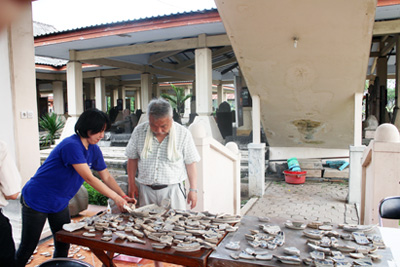
analysis work in Trowulan | |
On July 20th, we will held an open lecture of ceramic analysis result for Trowulan Site, Indonesia, with Association of Southeast Asian Archaeology, as followed; place: Showa Women University \'Kenkyukan\' 7F 7L04 room 7 minutes from Sangen-jaya station of Denen-toshi line, Tokyo program: 2:30 - 5:00 (open 2:00) 1. Sakai Takashi: Majapahit Kingdom and international collaboration study 2. Ohashi Koji: The real image of Majapahit by result of ceramic analysis for Trowulan Site |
23. The 2nd Analysis for ceramic shards found in Trowulan Site, Indonesia
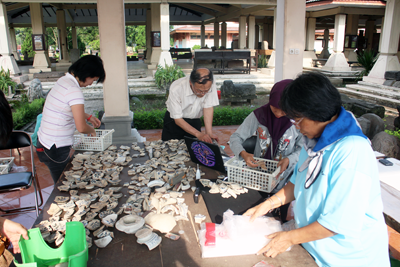
the condition of analysis | |
As continued activity by 2012, we held the analysis for ceramic shards, found in Trowulan Site, East Java, Indonesia, by collaboration with Indonesian National Archaeology Research Center in April, 2013. The main target of analysis in this time was the Vietnamese wares, the highest volume, and Thai wares, counted large number also. As the result, it had been cleared that the Vietnamese wares ware carried into Trowulan since the early period as like as Chinese wares. Moreover, we could identified numerous number of Vietnamese dolls and glazed tiles among these shards. For the result of the analysis, Prof. Ohashi Koji, the chief director, will present at the study building 7L04 room, Showa Women University (Sangen-jaya of Denentoshi Line, Tokyo), in 14:30 July 20th. |
24. Research of the Mysterious Majapahit Kingdom in Fukuoka & Tokyo
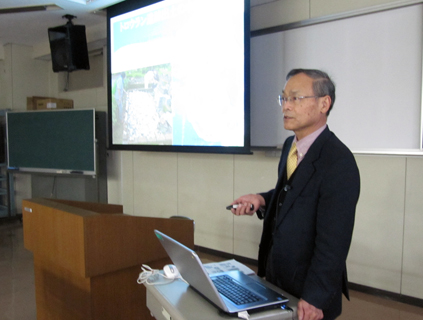
Lecture of Ohashi Koji in Fukuoka | |
We already held a lecture with title of Research of the Mysterious Majapahit Kingdom in Fukuoka Archaeology Center on April 14th. Mr.Ohashi Koji, the chief directer, and Mr. Sakai Takashi, vice chief directer, presented the result of ceramic shards analysis in Trowulan Site, Indonesia. A relative much number of peoples participated in this meeting, although the traffic location was not convenient. Similar lecture meeting with addition more information will be held on July 15th in the 1st Meeting Room of Tokyo Bunka Kaikan (front of Koenguchi Entrance in Ueno Station, JR line). It will be done from 2:00 pm (open 1:30 pm) until 4:30 with showing visual presentation for superior quality ceramics around 14th century found in this site. |
25. Ceramic Classification of Trowulan Site, Indonesia
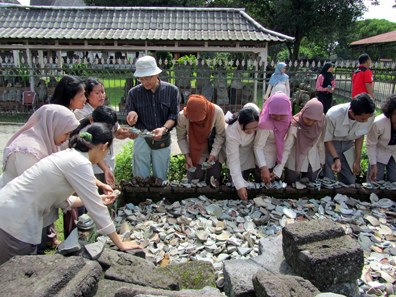
Rough classification in the storage | |
We practiced technical support activity for ceramic shads classification research of Indonesian National Archaeological Research Center at Trowulan Site, East Java in January 2012. This site is the famous historical capital ruins of the Majapahit Kingdom during the 14th and 15th century. After the 1920\'s numerous number of ceramic shards was unearthed in long time research, we firstly did classification on the main part, which is keeping in the Trowulan Site Museum. As object of the first activity, we chose Chinese blue & white, celadon and white porcelain, then could confirmed the existence of superior quality of porcelain in the 14th century such as Yuan blue & white. Also it became to clear the early import condition of superior celadon and white porcelain in the 11th century. By research of this time, we can began to understand the characteristics of this site, the largest historical site in Indonesia. |
26. Lecture of Ohashi Koji Chief Director on July 9th
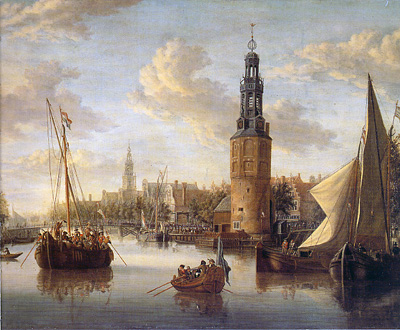
Amsterdam in the end of 17th century | |
We will held an lecture of Prof. OHASHI,Koji, our Chief Director, in Tokyo as followings. We will welcome your attendance. Date: July 9th (STA) Time: 1430 - 1630 (free) Place: minor meeting room no.1 in Tokyo Bunka Kaikan (close to Koenguchi Exit of Ueno Station in JR Lines) Title: New Knowledge of ceramics found in Netherlands, the early Imari, the early polychrome of Hizen, large jar of Karatsu and restoration technique of ceramics It could be cleared in Netherlands the existence of Hizen wares in the middle of 17th century such as the early Imari, the early polychrome of Hizen and large jar of Karatsu ware that had been unknown before research in this year. Also got new information of ceramic restoration technique in Netherlands. Such new research results will be presented with showing of much pictures. |
27. Conference for socialization of research result of Wolio Fort Ruins, Buton at Jan.29, 2011
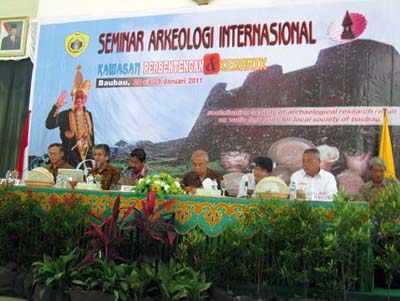
speakers on the stage | |
It was held the socialization conference for our research result of Wolio Fort Ruins, Buton Island, during 2004-06 in Baubau at Jan.29th. This conference was co-organized by the National Archaeological Research Center and Baubau City Government with about 230 assembly who are mainly school teachers.The following speakers presented the essence of study results;IKUTA,Shigeru: History of Buton based on VOC recordsOHASHI,Koji: The important findings of porcelainNOGAMI,Takenori: The important findings of stonewareTAKIMOTO,Tadashi: Wall and moat of Wolio FortSONNY,Wibisono: Buton and neighboring Islamic sitesINAGAKI,Masahiro: Japanese forts during 16-17th centuriesMIYAGI,Hiroki: Gusuku sites in OkinawaSAKAI,Takashi: Forts in Southeast Asia and IndiaFor each presentation, it was asked much questions by participants, then our foreign researchers could made exchange with local peoples. |
28. Lecture of Ohashi Koji Chief Director on July 3rd
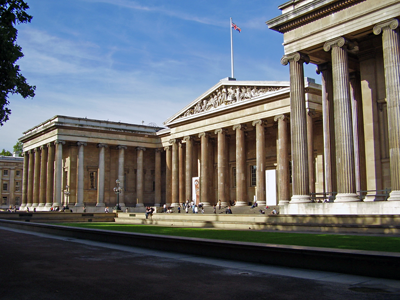
The British Museum | |
Date: July 3rd 2:00-5:00 pm (rally 1:50)Place: Institute of Industrial Science, the University of Tokyo Komaba Research Campus As-building 301 room about 10 min. walk from: Odakyu Line Higashikitazawa/Inokashira Line Komaba-todaimaeTheme: Ceramic Distribution in England during 17-18th century -concentrated Oriental Ceramics-Result of recent research in collection of several museums, UK Attention: Keeping rally time at entrance of As-building |
29. 2009 Lecture of Mr.Ohashi Koji, the Director, in Tokyo at July 11th

Director Mr.Ohashi Koji | |
Theme: 350 memorial years of Old Imari export to EuropeDate: July 11th pm2:30-4:30Place: Study Room No.1, 1 F, Edo-Tokyo Museum (Ryogoku, Tokyo)Old Imari ware (Hizen porcelain), most popular ware in Japan, was exported in massive quantity during 2nd half of the 17th to 1st half of the 18th century. Besides firstly market in Southeast Asia, also it was carried to Europe by Dutch and English, has base in Indonesia.In 2nd half of the 17th century, Old Imari was produced as substitute of Chinese Jingdezheng ware that could not be exported due to the Civil War for change of Ming/Qing, and quickly swept over the world ceramic market. Mr. Ohashi who has long filed study experience for its export to Europe, pointed out new theory of multi trade route of Old Imari export based on research in England or East Europe. European collections of Old Imari ware show us relationship Japan and Europe via Southeast Asia at Pre-Modern Age.At this time, he will explain with much pictures a basic understanding of Old Imari trade to Europe suited practice of Old Imari in Europe Exhibition at coming autumn. |
30. Lecture of Dr.Ohashi Koji, the Director, in Fukuoka at April 18th
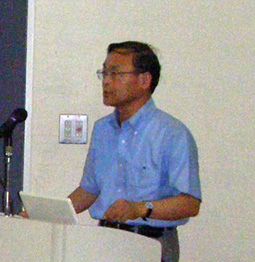
Dr.Ohashi Koji | |
We will practice a special lecture of Dr.Ohashi Koji with topic of study on Asian exoport of Hizen ware.Date: April 18thPlace: Fukuoka City Archaeological Center(Tel.092-571-2921, www.city.fukuoka.lg.jp/maibun/html/index.html)Time: 10:00-12:00Title: Imari with Korean ware, ant towards to AsiaComment: Dr.Sakai Takashi |
31. Lecture of Ohashi Koji, Chief Directer
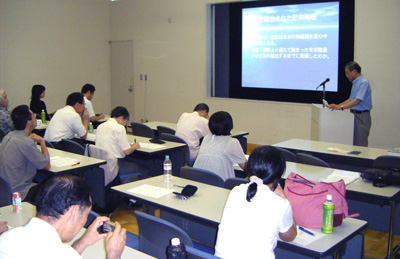
Ohashi Chief Director lectured | |
The lecture meeting of Ohashi Koji, our Chief Director, held July 20th with cooperation Japan Society of Southeast Asian Archaeology at Edo-Tokyo Museum in Tokyo, was a success with 30 more participants. He spoke mainly condition of Southeast Asia in where rich archaeological data, although lecture title was \'The Hizen Wares exported World, added new results of study\'. Especially, it was explained simply the characteristics of distribution in each area shown by the tendency of finding for several kinds of products. In this perspective, he pointed out a large possibility that Hizen wares found recently in Vientiane, Laos were carried from not Vietnam but Thailand. Also with showing concrete examples told some special ordered goods a hand washing set for Turkey or a chocolate cup for Cuba, and the thick distribution in several areas strongly related with the Dutch. Participants satisfied enough to interest about his all topics. |
32. Lecture of Mr.Ohashi Koji, the Director, in Tokyo at July 20th
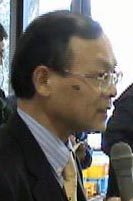
Ohashi Koji Director | |
We shall schedule an open lecture by Director Ohashi Koji, former director of Saga prefectural Ceramic Museum, in Tokyo at July 20th. #topic: Hizen Wares exported to the world, added the results of new studies #date: 2:00-4:00 afternoon, July 20th #place: lecture room 2 in Edo Tokyo Museum (5 minutes from Ryogoku station of JR line or Tokyo Metro) #entrance: free It will be explained with a lot of pictures in based archaeological findings for outline of the export of Hizen wares that had be done from late half of the 17th to early half of the 18th centuries. Especially, will be concentrated the condition of Southeast Asia included new data such as finding in Laos. |
33. New Publication: Research Report Book of Banten-Tirtayasa Site & Wolio Castle Ruins, Buton
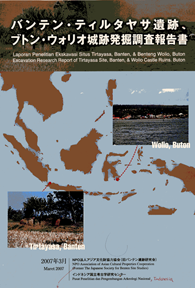
| |
On May 26th it will be published the 3rd report book for our archaeological joint reserach with The National Archaeological Research Center in Indonesia, EXCAVATION RESERACH REPORT OF TIRTAYASA SITE, BANTEN & WOLIO CASTLE RUINS, BUTON. In this book we reported significant result from the research on 2004/06; structure of the Sujung worter gate in Tirtayasa Site on later half of the 17th century, and enormous ceramc shards of pre-modern age in Wolio Castel Ruins including the special export style for Europe of Japanese Imari ware. This book, all 272 pages of A4 sizen (color photograph 16 page and black & white 108 page) in Japanse and Bahasa Indonesia, will be sell with price US$25 for a copy (including postage). |
34. Report Meeting of Indonesian Research in 2006
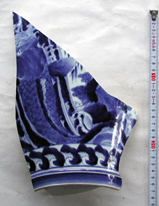
Hizen Large Jar from Wolio | |
We will held a release report meeting for our Indonesian research in 2006, as following; Date: February 3rd 2007 Place: Archeological Research Office of Tokyo University (The 56th Building 2F in Research Campus in Komaba, Tokyo 5 min. from Komaba-todaimae station of Inokashira Line Tel.03-5452-5103) Schedule 15:00/15:40 SAKAI Takashi: Outline of Results of Indonesian Research in 2006 15:40/16:20 OHASHI KOJI: Ceramics Found in the Wolio Castle Ruins, Buton 16:20/16:30 qustion and answer |
35. The Joint Excavation Research in Indonesia (August & September, 2006)
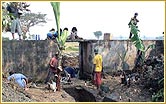
Research in the Tirtayasa Site | |
The excavation research in Tirtayasa Sites, Banten and the Wolio Castle Ruins, Buton Island that had continued up to now was executed in cooperation with the Indonesian National Archeology Research Center. The excavation in Tirtayasa became the seventh times, and was able to understand a whole structure of the Sujung sluice ruins. In the third research of the Wolio Castle Ruins excavated the moat that existed outer southern wall, and the character was clarified. Each result of the research after 2004 will be published in the research report book of the schedule for 2007. |
36. The 7th Ceramic Special Training (July, 2006)
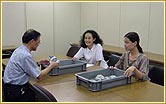
Training in the Kyushu Ceramic Museum, Arita | |
In inviting Ms.Ekowati, Jakarta National Museum and Ms.Wang Su-chin who researched ceramic shards of Zeelandia Castle Ruins in Taiwan, we took the training of newest ceramic research on 3 weeks in the Kyushu Ceramic Museum at Arita and the Machida City Museum at Tokyo. Without any problem, it became the opportunity of a new exchange expansion though it was training by the participant between multinational, differed up to now. |
37. International Joint Inspection to Turkish Ceramic Ruins (March, 2006)
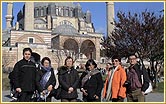
Joint Inspection in Edirne, Turkey | |
To form the wide network of the ceramic trade research, several ruins in Turkey, the west edge of the Asian ceramic trade at the early modern age, were inspected with the researchers, Ms.Naniek from Indonesia and Prof.Hsie Mingliang from Taiwan, the relay point of the Hizen ceramic trade. An active discussion bounced during eight days inspection at Iznik, Kyutahya etc. with Mr.Omur TUFAN in guided, curator of the Topkapi Palace Museum. |
|